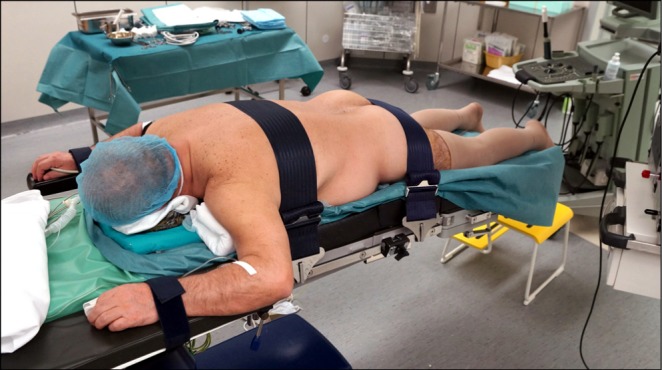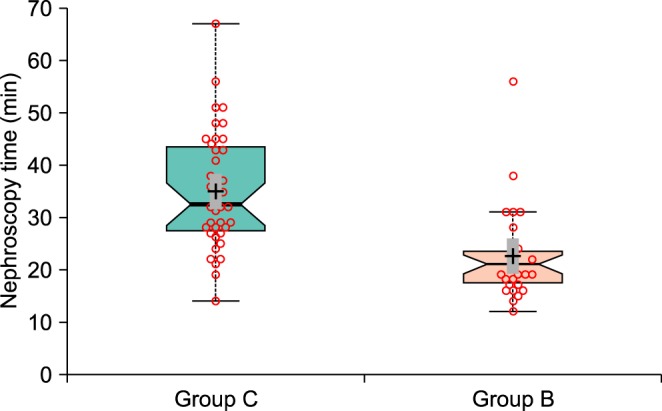Investig Clin Urol.
2017 May;58(3):179-185. 10.4111/icu.2017.58.3.179.
Evaluation of the effect of Bernoulli maneuver on operative time during mini-percutaneous nephrolithotomy: A prospective randomized study
- Affiliations
-
- 1The Federal State Institute of Public Health ‘The Nikiforov Russian Center of Emergency and Radiation Medicine’, Saint-Petersburg, Russia. nariman.gadjiev@gmail.com
- 2Department of Urology, University of California, Irvine, CA, USA.
- 3Muljibhai Patel Urological Hospital, Nadiad, India.
- 4The Saint-Petersburg State University clinic, Saint-Petersburg, Russia.
- 5Second City Hospital, Astana, Kazakhstan.
- KMID: 2388062
- DOI: http://doi.org/10.4111/icu.2017.58.3.179
Abstract
- PURPOSE
To evaluate the effect of "˜Bernoulli maneuver' (bringing the access sheath to horizontal plane) on operative time and stone free rates in patients undergoing mini-percutaneous nephrolithotomy (PCNL).
MATERIALS AND METHODS
All consecutive patients with a solitary kidney stone undergoing a mini-PCNL between 2015 and 2016 were included into this study. Patients were randomized either to standard prone or control (C) group patients or to tilted prone with "˜Bernoulli maneuver' group (B) patients. Pre-, intra-, and postoperative characteristics of these 2 groups were recorded and analyzed.
RESULTS
A total of 67 patients were included in the study. Of these, 40 patients were randomized to group C and 27 to group B. The mean (95% confidence limits) stone size (mm) in group C and B was 14 (13, 15) and 13 (11, 14), respectively (p=0.26). Nephroscopy time was shorter in Bernoulli group (35 minutes vs. 23 minutes, p=1.5·10â»âµ, and Bayes factor BFâ‚â‚€=2,340, and Cohen standardized effect size d(st)=1.2). The difference made it up 12 minutes (with 95% confidence interval from 8 to 18 minutes). There were no statistically significant differences between groups regarding white blood cell, creatinine level and stone-free status defined by computed tomography on the first postoperative day.
CONCLUSIONS
In our study the "˜Bernoulli maneuver' led to a shorter nephroscopy time in mini-PCNL. This maneuver can significantly reduce nephroscopy time and save significant amount of operative time, especially in tertiary referral centers with high-volume mini-PCNL procedures.
MeSH Terms
Figure
Reference
-
1. Fernström I, Johansson B. Percutaneous pyelolithotomy: a new extraction technique. Scand J Urol Nephrol. 1976; 10:257–259. PMID: 1006190.2. Helal M, Black T, Lockhart J, Figueroa TE. The Hickman peel-away sheath: alternative for pediatric percutaneous nephrolithotomy. J Endourol. 1997; 11:171–172. PMID: 9181444.
Article3. Nagele U, Horstmann M, Sievert KD, Kuczyk MA, Walcher U, Hennenlotter J, et al. A newly designed amplatz sheath decreases intrapelvic irrigation pressure during mini-percutaneous nephrolitholapaxy: an in-vitro pressure-measurement and microscopic study. J Endourol. 2007; 21:1113–1116. PMID: 17941796.
Article4. Nicklas AP, Schilling D, Bader MJ, Herrmann TR, Nagele U. Training and Research in Urological Surgery and Technology (T.R.U.S.T.)-Group. The vacuum cleaner effect in minimally invasive percutaneous nephrolitholapaxy. World J Urol. 2015; 33:1847–1853. PMID: 25833660.
Article5. Eastwell PH. Bernoulli? Perhaps, but what about viscosity? Sci Educ Rev. 2007; 6:1–13.6. Türk C, Petřík A, Sarica K, Seitz C, Skolarikos A, Straub M, et al. EAU guidelines on interventional treatment for urolithiasis. Eur Urol. 2016; 69:475–482. PMID: 26344917.
Article7. Mishra S, Jagtap J, Sabnis RB, Desai MR. Training in percutaneous nephrolithotomy. Curr Opin Urol. 2013; 23:147–151. PMID: 23357932.
Article8. Gadzhiev N, Brovkin S, Grigoryev V, Tagirov N, Korol V, Petrov S. Sculpturing in urology, or how to make percutaneous nephrolithotomy easier. J Endourol. 2015; 29:512–517. PMID: 25321395.
Article9. Raman JD, Bagrodia A, Gupta A, Bensalah K, Cadeddu JA, Lotan Y, et al. Natural history of residual fragments following percutaneous nephrostolithotomy. J Urol. 2009; 181:1163–1168. PMID: 19152935.
Article10. Hammer Ø, Harper DA, Ryan PD. PAST: paleontological statistics software package for education and data analysis. Palaeontol Electron. 2001; 4:9–18.11. Faul F, Erdfelder E, Lang AG, Buchner A. G*Power 3: a flexible statistical power analysis program for the social, behavioral, and biomedical sciences. Behav Res Methods. 2007; 39:175–191. PMID: 17695343.12. Kumar P, Bach C, Kachrilas S, Papatsoris AG, Buchholz N, Masood J. Supine percutaneous nephrolithotomy (PCNL): ‘in vogue’ but in which position? BJU Int. 2012; 110(11 Pt C):E1018–E1021. PMID: 22564784.
Article13. Ganpule AP, Bhattu AS, Desai M. PCNL in the twenty-first century: role of Microperc, Miniperc, and Ultraminiperc. World J Urol. 2015; 33:235–240. PMID: 25316173.
Article14. Mishra S, Sharma R, Garg C, Kurien A, Sabnis R, Desai M. Prospective comparative study of miniperc and standard PNL for treatment of 1 to 2 cm size renal stone. BJU Int. 2011; 108:896–899. PMID: 21477212.15. Wright A, Rukin N, Smith D, De la Rosette J, Somani BK. ‘Mini, ultra, micro’ - nomenclature and cost of these new minimally invasive percutaneous nephrolithotomy (PCNL) techniques. Ther Adv Urol. 2016; 8:142–146. PMID: 27034726.
Article16. Sabnis RB, Ganesamoni R, Sarpal R. Miniperc: what is its current status? Curr Opin Urol. 2012; 22:129–133. PMID: 22273758.17. Helal M, Black T, Lockhart J, Figueroa TE. The Hickman peel-away sheath: alternative for pediatric percutaneous nephrolithotomy. J Endourol. 1997; 11:171–172. PMID: 9181444.
Article18. Jackman SV, Hedican SP, Peters CA, Docimo SG. Percutaneous nephrolithotomy in infants and preschool age children: experience with a new technique. Urology. 1998; 52:697–701. PMID: 9763096.
Article19. Lahme S, Bichler KH, Strohmaier WL, Götz T. Minimally invasive PCNL in patients with renal pelvic and calyceal stones. Eur Urol. 2001; 40:619–624. PMID: 11805407.
Article20. Rassweiler J, Rassweiler MC, Klein J. New technology in ureteroscopy and percutaneous nephrolithotomy. Curr Opin Urol. 2016; 26:95–106. PMID: 26626887.
Article21. Nagele U, Nicklas A. Vacuum cleaner effect, purging effect, active and passive wash out: a new terminology in hydrodynamic stone retrival is arising--Does it affect our endourologic routine? World J Urol. 2016; 34:143–144. PMID: 26002252.
Article22. Yamaguchi A, Skolarikos A, Buchholz NP, Chomón GB, Grasso M, Saba P, et al. Operating times and bleeding complications in percutaneous nephrolithotomy: a comparison of tract dilation methods in 5,537 patients in the Clinical Research Office of the Endourological Society Percutaneous Nephrolithotomy Global Study. J Endourol. 2011; 25:933–939. PMID: 21568697.
Article23. Knoll T, Wezel F, Michel MS, Honeck P, Wendt-Nordahl G. Do patients benefit from miniaturized tubeless percutaneous nephrolithotomy? A comparative prospective study. J Endourol. 2010; 24:1075–1079. PMID: 20575685.
Article24. Hu G, Guo Z, Liu H, Luo M, Liu M, Lai P, et al. A novel minimally invasive percutaneous nephrolithotomy technique: safety and efficacy report. Scand J Urol. 2015; 49:174–180. PMID: 25247463.
Article
- Full Text Links
- Actions
-
Cited
- CITED
-
- Close
- Share
- Similar articles
-
- Comparison of Simultaneous with Sequential Procedure in Bilateral Percutaneous Nephrolithotomy
- Ultrasound-guided anterior quadratus lumborum block for postoperative pain after percutaneous nephrolithotomy: a randomized controlled trial
- Percutaneous Nephrolithotomy in Kyphosis Patients
- Percutaneous Nephrolithotomy: 57 Cases
- Percutaneous management of staghorn renal calculi





